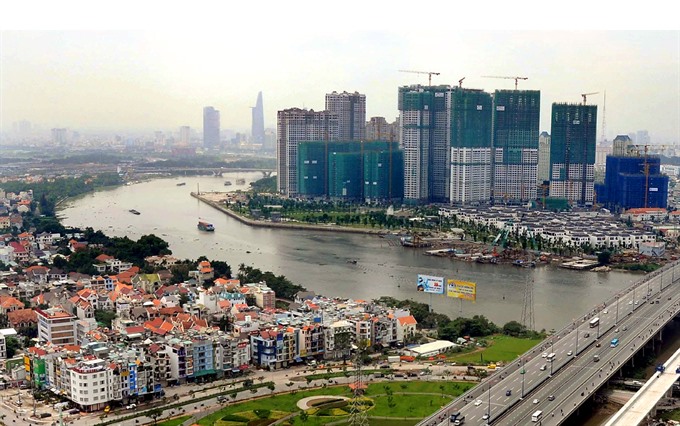 Politics & Law
Politics & Law

The National Assembly (NA) was growing restless against the tremendous losses of state-owned enterprises (SOEs) which were posing risks to the Government's ambitious plan to restructure the economy.
 |
| A section of HCM City’s Metro Route No 1 crossing the Sài Gòn River. NA deputies yesterday expressed their worries that loss-making State-owned enterprises would inhibit implementation of the five-year National Economic Restructuring plan. — VNA/VNS Photo An Hiếu |
HÀ NỘI — State-owned enterprises’ (SOEs) tremendous loses have been causing the National Assembly (NA) to grow restless about risks to the Government’s ambitious plan to restructure the economy.
During the eleventh day of the second meeting session of the newly-elected NA—which was broadcast live on TV yesterday—NA deputies made comments on the five-year national economy restructuring plan toward 2020. The hobbling performances of several SOEs surfaced as one of the "biggest concerns of the citizens", said deputy Nguyễn Hữu Cầu from Nghệ An Province.
"The budget for development investment was very limited, disproportionately from foreign loans," he said. "But looking at the five recent colossal projects carried out by the SOEs, I was so worried".
Those hundreds of million dollars mega-projects, initially seen through the rose-tinted glasses of leading manufacturers in their producing sectors, became a heavy burden on the Government as they failed to produce anything of value. In a report sent to the NA, the Government singled out the Đình Vũ polyester manufacturing plant in Hải Phòng city (investment amount of US$315 million), the Dung Quất bio-ethanol plant in Quảng Ngãi Province ($85.5 million), the Phương Nam pulp mill in Long An province ($135 million) and the Ninh Bình fertilizer plant in Ninh Binh Province ($540 million). Combined, these projects have suffered a total loss of over VNĐ7.3 trillion ($328.5 million) and counting.
Another mega-project was the Thái Nguyên iron and steel mill in Thái Nguyên Province, of which the money poured in doubled from VNĐ3.84 trillion to more than VNĐ8.1 trillion. The under-construction mill was left unattended since 2013 due to capital shortage, and the Government was left scratching its head about ways to deal with the project.
"I urge the Government to address those projects as soon as possible in order to avoid having new debts lapped over old debts," Cầu said.
"Individuals and organisations responsible for such situations should also be handled strictly and reported to the NA," he added.
While deputy Phạm Phú Quốc from HCM City asked to set up a department in charge of managing State budget and assets within every SOE in order to supervise and tighten the use of public capital, Hà Nội’s deputy Lê Quân called for "bolder State divestment from all SOEs," except for those fundamental to national or social security.
"After divestment, (ex-SOEs) firms tend to run more effectively and hence, pay more taxes to the Government", Quân said.
"There is a large sum of money in the society that hasn’t been given the chance for investment yet. If the Government divests from the SOEs and lets the private sector fill its place, it can lead to better capital efficiency and create a bigger budget to invest in infrastructure and human resources".
Currently there are 718 SOEs under full control of the Government. The latest equitisation route map for the 2016-2020 period plans that the number of SOEs having 100 per cent state-funded capital would be slashed down by nearly four times to 190 firms.
Localities’ economy
NA deputies also asked for a general economic plan on a national and regional scale other than letting each locality decide on its own way of development.
"[Autonomous local development] would result in scattered investment and put localities out of sync with each other or the whole country," said deputy Cao Đình Thưởng of Phú Thọ Province.
Regional linkage—particularly in economic co-operation—meanwhile, was still relatively weak despite orientation and support from the Government since as early as 1996, said Đà Nẵng’s deputy Nguyễn Bá Sơn.
"Regional linkage now is just plain connection among adjacent provinces and cities with non-legally binding agreements. Localities, in fact, compete with each other to draw in investment by laying out heaps of favourable conditions for investors, which in many cases creates an unhealthy environment," he said.
This kind of competition led to several investment plans in different localities, and it also led to different regions—for example the Mekong Delta, the Central Highlands or the northwestern region—overlapping with each other, wasting money and resources that should go toward effective economic development.
Son cited the example of how a developing country like Việt Nam now already has 21 airports, of which 10 are international.
"Almost every locality wants to build an airport or a port, but it really pulls down the economic benefits of the whole country," he said. — VNS




